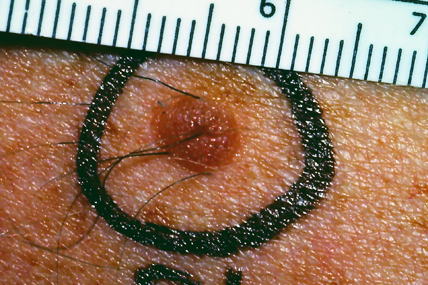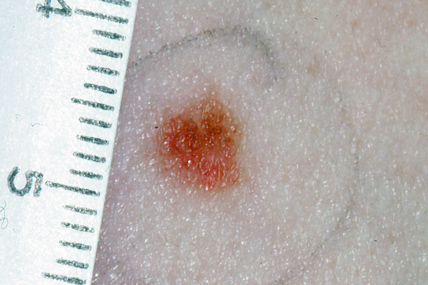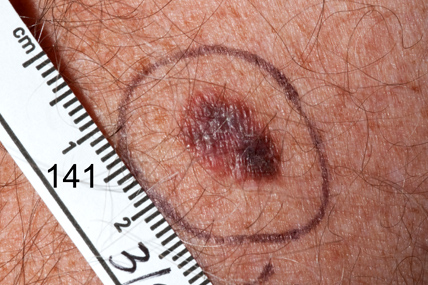Moles to Melanoma: Recognizing the ABCDE Features
Before You Get Started
To make this resource as useful as possible, please make sure you review and understand the following information.
The National Cancer Institute has collected photographs of 29 different pigmented skin lesions, presented as case series, to help patients and other individuals recognize common moles, dysplastic nevi (DN), and melanomas that started from DN. Each case series shows changes in an individual pigmented lesion (mole) over time and across the various mole changes typically seen in individuals from U.S. melanoma-prone families.
- Common Moles - A non-cancerous growth on the skin that is formed by a cluster of melanocytes (cells that make a substance called melanin, which gives color to skin and eyes). A mole may be dark or flesh-colored and may be raised from the skin.
- Dysplastic Nevi (DN) - A type of mole that may develop into a type of skin cancer called malignant melanoma. They look different from common moles. A DN is often larger with borders that are not easy to see. Its color is usually uneven and can range from pink to dark brown. Parts of the mole may be raised above the skin surface.
- Melanoma - A form of cancer that begins in melanocytes (cells that make the pigment melanin). It may begin in a mole (skin melanoma), but can also begin in other pigmented tissues, such as in the eye or in the intestines.
This resource is intended for patients and others in the lay public. It only includes images of individuals who are at the highest risk of developing melanoma (i.e. Caucasians). Additional information, including resources for other racial and ethnic groups, can be found in the Intended Audience section.
This resource provides information about and examples of: common moles, dysplastic nevi (atypical moles) and melanoma. This collection does not include any pictures of non-melanoma types of skin cancer (e.g. basal cell or squamous cell). Since they arise from different cell types in the skin, they look very different from melanoma. Additional information, including resources for other types of non-melanoma skin cancer, can be found in the Intended Audience section.
The "ABCDE" rule describes the features of early melanoma. These features are:
 Asymmetry - The shape of one half does not match the other half.
Asymmetry - The shape of one half does not match the other half. Border that is irregular - The edges are often ragged, notched, or blurred in outline. The pigment may spread into the surrounding skin.
Border that is irregular - The edges are often ragged, notched, or blurred in outline. The pigment may spread into the surrounding skin. Color that is uneven - Shades of black, brown, and tan may be present. Areas of white, gray, red, pink, or blue may also be seen.
Color that is uneven - Shades of black, brown, and tan may be present. Areas of white, gray, red, pink, or blue may also be seen. Diameter - There is a change in size, usually an increase. Melanomas can be tiny, but most are larger than 6 millimeters wide (about 1/4 inch wide).
Diameter - There is a change in size, usually an increase. Melanomas can be tiny, but most are larger than 6 millimeters wide (about 1/4 inch wide). Evolving - The mole has changed over the past few weeks or months.
Evolving - The mole has changed over the past few weeks or months.
View Photographs
Please click on the images below to view examples of moles, dysplastic nevi, and melanoma.

Common Moles
A non-cancerous growth on the skin that is formed by a cluster of melanocytes (cells that make a substance called melanin, which gives color to skin and eyes). A mole may be dark or flesh-colored and may be raised from the skin.

Dysplastic Nevi (DN)
A type of mole that may develop into a type of skin cancer called malignant melanoma. They look different from common moles. A dysplastic nevus is often larger with borders that are not easy to see. Its color is usually uneven and can range from pink to dark brown. Parts of the mole may be raised above the skin surface.

Melanoma
A form of cancer that begins in melanocytes (cells that make the pigment melanin). It may begin in a mole (skin melanoma), but can also begin in other pigmented tissues, such as in the eye or in the intestines.
